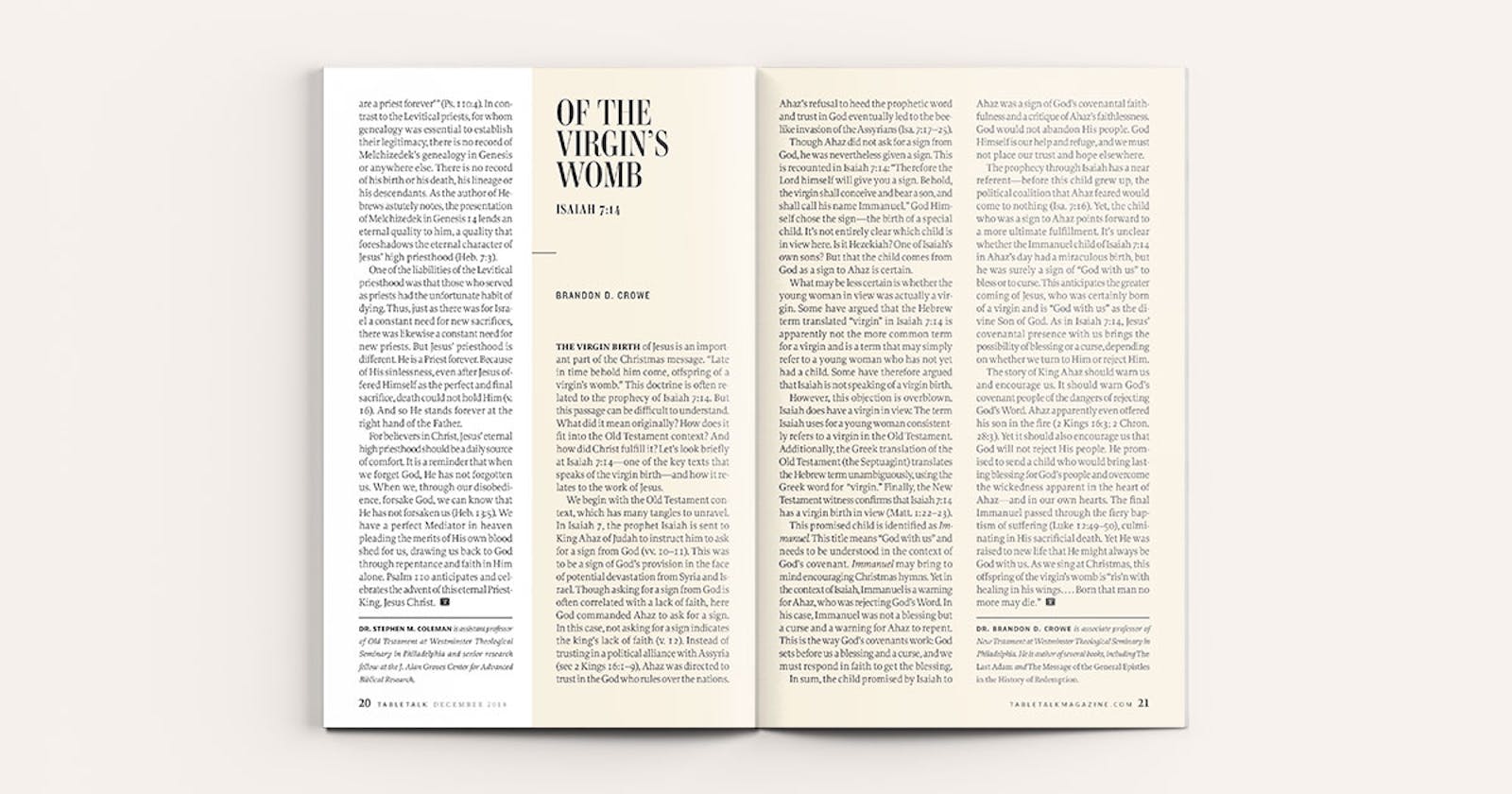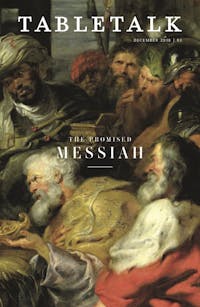
Request your free, three-month trial to Tabletalk magazine. You’ll receive the print issue monthly and gain immediate digital access to decades of archives. This trial is risk-free. No credit card required.
Try Tabletalk NowAlready receive Tabletalk magazine every month?
Verify your email address to gain unlimited access.
The virgin birth of Jesus is an important part of the Christmas message. “Late in time behold him come, offspring of a virgin’s womb.” This doctrine is often related to the prophecy of Isaiah 7:14. But this passage can be difficult to understand. What did it mean originally? How does it fit into the Old Testament context? And how did Christ fulfill it? Let’s look briefly at Isaiah 7:14—one of the key texts that speaks of the virgin birth—and how it relates to the work of Jesus.
We begin with the Old Testament context, which has many tangles to unravel. In Isaiah 7, the prophet Isaiah is sent to King Ahaz of Judah to instruct him to ask for a sign from God (vv. 10–11). This was to be a sign of God’s provision in the face of potential devastation from Syria and Israel. Though asking for a sign from God is often correlated with a lack of faith, here God commanded Ahaz to ask for a sign. In this case, not asking for a sign indicates the king’s lack of faith (v. 12). Instead of trusting in a political alliance with Assyria (see 2 Kings 16:1–9), Ahaz was directed to trust in the God who rules over the nations. Ahaz’s refusal to heed the prophetic word and trust in God eventually led to the bee-like invasion of the Assyrians (Isa. 7:17–25).
Though Ahaz did not ask for a sign from God, he was nevertheless given a sign. This is recounted in Isaiah 7:14: “Therefore the Lord himself will give you a sign. Behold, the virgin shall conceive and bear a son, and shall call his name Immanuel.” God Himself chose the sign—the birth of a special child. It’s not entirely clear which child is in view here. Is it Hezekiah? One of Isaiah’s own sons? But that the child comes from God as a sign to Ahaz is certain.
What may be less certain is whether the young woman in view was actually a virgin. Some have argued that the Hebrew term translated “virgin” in Isaiah 7:14 is apparently not the more common term for a virgin and is a term that may simply refer to a young woman who has not yet had a child. Some have therefore argued that Isaiah is not speaking of a virgin birth.
However, this objection is overblown. Isaiah does have a virgin in view. The term Isaiah uses for a young woman consistently refers to a virgin in the Old Testament. Additionally, the Greek translation of the Old Testament (the Septuagint) translates the Hebrew term unambiguously, using the Greek word for “virgin.” Finally, the New Testament witness confirms that Isaiah 7:14 has a virgin birth in view (Matt. 1:22–23).
This promised child is identified as Immanuel. This title means “God with us” and needs to be understood in the context of God’s covenant. Immanuel may bring to mind encouraging Christmas hymns. Yet in the context of Isaiah, Immanuel is a warning for Ahaz, who was rejecting God’s Word. In his case, Immanuel was not a blessing but a curse and a warning for Ahaz to repent. This is the way God’s covenants work: God sets before us a blessing and a curse, and we must respond in faith to get the blessing.
In sum, the child promised by Isaiah to Ahaz was a sign of God’s covenantal faithfulness and a critique of Ahaz’s faithlessness. God would not abandon His people. God Himself is our help and refuge, and we must not place our trust and hope elsewhere.

The prophecy through Isaiah has a near referent—before this child grew up, the political coalition that Ahaz feared would come to nothing (Isa. 7:16). Yet, the child who was a sign to Ahaz points forward to a more ultimate fulfillment. It’s unclear whether the Immanuel child of Isaiah 7:14 in Ahaz’s day had a miraculous birth, but he was surely a sign of “God with us” to bless or to curse. This anticipates the greater coming of Jesus, who was certainly born of a virgin and is “God with us” as the divine Son of God. As in Isaiah 7:14, Jesus’ covenantal presence with us brings the possibility of blessing or a curse, depending on whether we turn to Him or reject Him.
The story of King Ahaz should warn us and encourage us. It should warn God’s covenant people of the dangers of rejecting God’s Word. Ahaz apparently even offered his son in the fire (2 Kings 16:3; 2 Chron. 28:3). Yet it should also encourage us that God will not reject His people. He promised to send a child who would bring lasting blessing for God’s people and overcome the wickedness apparent in the heart of Ahaz—and in our own hearts. The final Immanuel passed through the fiery baptism of suffering (Luke 12:49–50), culminating in His sacrificial death. Yet He was raised to new life that He might always be God with us. As we sing at Christmas, this offspring of the virgin’s womb is “ris’n with healing in his wings. . . . Born that man no more may die.”
